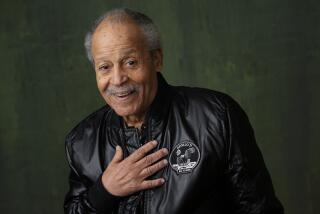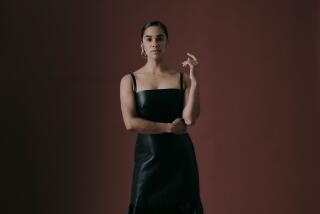Astronaut Proudly Sends Stereotypes to the Moon
Dr. Mae Jemison, NASA’s only black female astronaut, takes pride and pleasure in shattering Space-Age stereotypes.
No, you don’t have to be in the military to be an astronaut, she tells audiences that invite her to speak. No, you don’t have to be male; no, you don’t have to be white.
“I like to bring to people a view of the space program they may not get,” says Jemison, 34, a physician who speaks four languages, collects African art and is trained in jazz and modern dance.
Jemison has plenty of opportunities to offer a fresh space perspective. She is besieged with requests for interviews and speeches, making her one of NASA’s most highly sought astronauts.
“People automatically think if you’re a black astronaut or a black celebrity that you appeal to mainly--or only--the black audience,” she says. “It’s just as important for a young white boy to see a black astronaut as a young black girl. Everyone has skills and talents, and no one has a lock on scientific ability or physical ability.”
Jemison doesn’t see herself as a role model, although she is pleased if young people are inspired by her achievements.
Jemison grew up in an inner-city neighborhood in Chicago, the youngest of three children. Her mother was a schoolteacher, her father a construction and maintenance worker.
She won a scholarship to Stanford University, where she studied chemical engineering and African and Afro-American studies. She was torn between medicine and dance as graduation approached.
“My mother told me if I went to medical school I could always go dancing. But if I was a dancer, I couldn’t always practice medicine.”
Jemison chose medicine. She worked at a refugee camp in Thailand while studying medicine at Cornell University and a few years later served as a Peace Corps medical officer for Sierra Leone and Liberia in West Africa.
Jemison was selected as an astronaut in 1987 while working as a general practitioner and attending graduate engineering classes in Los Angeles. She had been interested in space since childhood and wanted the chance to “influence where a new field is going to be headed.”
She set aside her work in tropical medicine and artificial organ design to concentrate on being an astronaut.
Jemison will make her first space flight next fall aboard the new shuttle Endeavour. The scientific research mission is a joint effort between NASA and the Japanese Space Agency.
“I do miss working in developing countries,” she says. “But, you know, you move on.”
More to Read
Sign up for Essential California
The most important California stories and recommendations in your inbox every morning.
You may occasionally receive promotional content from the Los Angeles Times.










